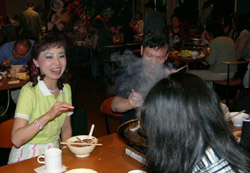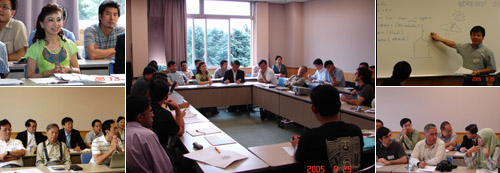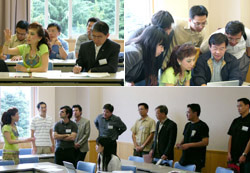Archilife Investingating Mission for SB05Tokyo (4)Date: 2005-09-25
Section: SB Series of International Conferences | 隨後由林得恩先生上台進行與實踐共生化有關之氣象方面調查方法論的演說「The Micro-climate Meteorological Station Data Feedback the Real Life Application and Adjustment for the Building」、羅陽青先生進行有關微生物方面之演說「How to Identify the Microorganisms?」、蔡坤憲先生進行有關節肢動物方面之演說「Bio-climatic Design of SB in Tropical & Subtropical Region Surveillance of Symbiotic Arthropods」及鍾政勳先生進行有關野菜方面之演說「Wild Edible Plants」。最後,則由黃晉英秘書長總結:「這四個重要工具當然不足以直接導出共生化(Symbiosis),其他相關的知識也必要累積,面對如此複雜的自然環境,我們需要更多的知識或專家來協助。因此,在此次的Student Session只能做個開頭,透過國際的分工與合作,在未來我們希望台灣可以做為協助者的角色,幫助各位繼續累積知識,完成屬於你們自己的永續建築(SB)。相信未來在各種研討會上,我們還有機會相互學習,也期盼這次簡短的Student Session可以給各位一個好的思考起點。在面對能源匱乏,全球氣候異變的情勢下,我們應做出革命性的行動,以綠建築(GB)加上共生化(Symbiosis)的行動達到永續建築(SB)的目標,鼓勵大家共同為人類的永續發展貢獻一份力量,我們期盼下一次的見面!」為時75分鐘的演說內容就此告一段落。在短暫中場休息後,開始進行熱烈的問答與研討。因為與會的學員大部分都是建築背景出身,所以提出的疑問大致上都環繞在祐生研究基金會的研究內容以及共生圈一號實驗的目的與方式上,而考察團的研究團隊們也開誠布公地予以解說,希望讓參與的學員們充分掌握第一手的資料,不虛此行。受限於時間的關係,研討必須劃下句點。
Then, Mr. Lin De-en went on the stage to present his report on " The Micro-climate Meteorological Station Data Feedback the Real Life Application and Adjustment for the Building", Mr. Luo Yang-ching the report on " How to Identify the Microorganisms?", Mr. Tsai Kun-hsien the report on " Bio-climatic Design of SB in Tropical & Subtropical Region Surveillance of Symbiotic Arthropods ",and Mr. Chung Cheng-hsin the report on " Wild Edible Plants ". Secretary General Huang Chin-ying drew the final conclusion after these reports,"Though these four tools are important, symbiosis can never be accomplished by these four tools alone. In fact, we need to accumulate relevant knowledge because we need much more knowledge and specializations to face the complex natural environment. Therefore, what we have just presented at this Student Session is just the beginning. Through international division of labor, we hope that Taiwan can be the coordinator to help you continually accumulate knowledge for accomplishing the SB of your own. We believe that there are great many chances for us to learn from one another in future conferences of different kinds. We wish that our toils at this brief Student Session can bring you a good start of thinking. In a time of energy shortage and global climate change, revolutionary actions should be taken to in order to accomplish SB by combining GB and symbiosis. We hereby urge every one of you to try you best for the sustainable development of mankind, and we are looking forward to seeing you next time!" The 75-minute speech ended at this moment, and the heated Q&A and discussions followed after a short intermission. As most participants have architecture background, most questions were about the content of the researches conducted by the Archilife Research Foundation and the objectives and approaches of the experiments at Symbiosphere 1 Center. Members of the research teams participating in the delegation did their best to answer all those questions, hoping to share the first-hand information with students at the meeting. The seminar was ended unwillingly because of time.
 所有人員隨即分搭二部巴士,在江哲銘評審委員與張桂鳳小姐的導覽下,前往參觀東京代官山地區,見證東京建築及都市發展的演進歷程。目前,這個區塊正在急速進入第 2 次開發的建設期。代官山曾是日本集體住宅的創始地,這些曾做為歷史象徵物的簡易公寓已被拆除,取而代之的是高層的綜合型購物中心。在考察團參訪的途中,到處充滿著散步與城市花園的氣氛,是出售各種日用小商品的市場,在代官山最容易找到獨具風格的服裝以及飾品,也就是各大百貨公司都沒有的風格,這裏銷售的貨品品質優良,尤其受到年輕女性的歡迎。參觀完後,考察團一行驅車前往新宿體驗一般日式吃到飽的用餐方式,讓考察團員更貼近日本民眾的生活脈動,從另一面觀察日本的風土民情。 所有人員隨即分搭二部巴士,在江哲銘評審委員與張桂鳳小姐的導覽下,前往參觀東京代官山地區,見證東京建築及都市發展的演進歷程。目前,這個區塊正在急速進入第 2 次開發的建設期。代官山曾是日本集體住宅的創始地,這些曾做為歷史象徵物的簡易公寓已被拆除,取而代之的是高層的綜合型購物中心。在考察團參訪的途中,到處充滿著散步與城市花園的氣氛,是出售各種日用小商品的市場,在代官山最容易找到獨具風格的服裝以及飾品,也就是各大百貨公司都沒有的風格,這裏銷售的貨品品質優良,尤其受到年輕女性的歡迎。參觀完後,考察團一行驅車前往新宿體驗一般日式吃到飽的用餐方式,讓考察團員更貼近日本民眾的生活脈動,從另一面觀察日本的風土民情。
Under the guidance of Mr. Chiang Che-ming and Miss Chang Kuei-feng, everybody went to Daikanyama on two buses to explore the history of architectural and urban development of Tokyo. The block was in its rapid second development. Daikanyama was the origin of collective housing in Japan. Those simple apartments that witnessed history have long been demolished and became multistory integrated shopping malls. During the trip, we felt the atmosphere of leisure and city garden and saw markets selling daily articles everywhere. Here in Daikanyama, we could find clothes and accessories of unique styles; i.e. styles that couldn't be found in department stores. Merchandises here were of high quality and favored by young ladies in particular. After the trip to Daikanyama, the delegation headed for Shinjuku to experience the one price for all general Japanese food, so that delegates could understand more about the true everyday lives of Japanese people, another kind of investigation of Japanese culture.

經過9月24日下午的教學研討後,9月25日上午研討會的重點即在起草學生聲明並加以定稿。這天,大家大清早搭車來到會場,準時召開研討會。會中在主席黃秘書長穿針引線、提綱挈領地引導下,只見大家七嘴八舌,比手劃腳地你來我往,討論好不熱烈,一直到大會的工作人員催促著散場時還欲罷不能。為搶時間,要求一向精確的黃晉英秘書長更是一刻都無法鬆懈地緊盯著螢幕,為成果把關,一旁的江哲銘評審委員、蘇慶華評審委員、李宏謨評審委員也熱心指導負責擬稿的李傳楷小姐、李彥頤先生及劉光盛先生用辭遣字,希望把祐生的理念與研討會的成果詮釋到令人滿意的程度。在大家的努力之下,終於趕在最後一刻把學生聲明完稿,也指定好來自古巴,熱情開朗的Abel在9月26日的學生會議閉幕式以及9月27日下午的Special Session上進行成果報告。任務告一段落後,大家總算放下心來驅車前往享用遲來的午餐以及至東京著名的地標:東京鐵塔以及皇居外苑參觀,轉換一下大家緊繃的心境,這也是到日本幾天以來最輕鬆愜意的一個下午了。

After the education session in the afternoon of September 24, the focus of the seminar in the morning of September 25 was the drafting and finalization of the Student Statement. Everybody got up very early and came to the venue. The seminar started on time. With Secretary General Huang Chin-ying serving as the go-between and bringing out the most essential points, people there were in heated debate and discussions, and there was no sign of a stop even when crews announced the time was over. As time was pressing, Secretary General Huang Chin-ying who has always been an exact person couldn't take her eyes off the screen in order to ensure the quality of the outcome. Mr. Chiang Che-ming, Mr. Su Ching-hua and Mr. Lee Horng-mo also gave diction advice to Miss Lee Chuan-kai, Mr. Li Yen-yi, and Mr. Liu Kuang-sheng who were responsible for drafting the statement, hoping to make the best interpretation possible of the beliefs of Archilife Research Foundation and the accomplishments of the seminars. The Student Statement was finally completed at the last minute with the concerted efforts of everybody. The passionate and cheerful Abel from Cuba was appointed to present the accomplishment report at the closing ceremony of the Student Session on September 26 and the Special Session held in the afternoon of September 27. After the mission was completed, everybody finally had the mood to enjoy the delayed lunch and the tour to the landmarks of Tokyo: the Tokyo Tower and the Imperial Palace as a relief of the stress. In fact, it was the most relaxing afternoon in Japan.
東京鐵塔建於1958年,原始用途為電視電波發射塔,高333米,是東京的象徵建築物之一。東京鐵塔建成當初,東京還處於重建之中,還是一個低建築的城市。因而東京鐵塔的出現就像是侵略進來的巨型怪獸一樣支配了東京的天空。東京鐵塔雖然比法國巴黎的艾菲爾鐵塔高33米,但它的總重量只有艾菲爾鐵塔的一半左右,這都歸功於鋼鐵和建築技術的進步,經過四十多年的建設﹐雖然現在它已不是那麼突出了,但依然是東京最著名的地標性建築之一,尤其是在夜晚,當它由下到頂被霓虹燈所裝扮起來時,格外引人注目。
As one of the symbolic architectures of Tokyo, the 333-meter-tall Tokyo Tower was built in 1958 for television broadcasting. The whole city was under reconstruction when the project initiated, and Tokyo was then a city of low construction. That is the reason why the tower was like a gigantic intruding monster occupying the Tokyo sky. Thanks to the technological advancement in steel-making and architecture, though the Tokyo Tower is taller than the Eiffel Tower by 33m, it is only half the weight of the latter. It has been nearly 50 years now and the tower is not as outstanding as it was before, it is still one of the most famous landmarks in Tokyo. It is exceptionally gorgeous and attractive in the evening when neon lights are on over its tip.

參觀東京鐵塔後,全團再往鄰近的皇居外苑參觀,擁有悠閒雅致風景的皇宮前廣場,是建築在江戶幕府重臣宅邸遺跡上的廣場,保養維護良好的草坪和松園,是上班族及觀光客躺下來感受貴氣中的寧靜、休憩最佳地點。此外,提起皇宮的觀光,則以二重橋最為有名。二重橋原為木造二層橋樑,依晉見日本天皇官員職位品秩高低大小,而決定其入宮行進位置,後因年久損壞而改由石材構築,雖橋樑外貌不復當年樣貌,但仍然承襲舊橋命名為二重橋,現為皇宮觀光最佳的拍照名勝地點。
The Imperial Palace was the next stop. The elegant, scenic plaza in front of the palace was built on top of the residence of an important official of the Edo Shogunates. The well-maintained lawn and pine garden was the ideal spot for officer workers and tourists to enjoy the noble serenity and leisure. Speaking of a tour to the imperial palace, the Nijubashi (Double Bridge) at the palace is the most famous spot. It was a dual-layer wooden bridge where officials summoned by the emperor lined up there according to their ranking in the olden days. Though it was rebuilt with stone after years of damage and its appearance was no more the same, it adopted the old name and has since become the best spot for photography when visiting the imperial palace.
|
|